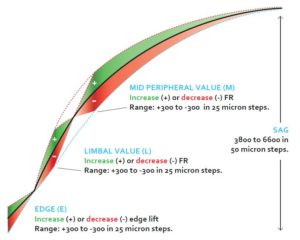An intuitive scleral lens that provides you with control to customize the ideal lens for highly irregular and medically indicated cornea or even normal corneas when a larger diameter is needed.
This brief 4-minute video below provides you with a full visual representation of the fitting philosophy, ease of fitting, and many benefits of Onefit MED. Learn to fit by signing up for virtual or in-person training today!
Attributes
Onefit MED provides practitioners with complete control over their scleral lens designs and fits. With a standard diameter of just 15.6mm, Onefit MED is unique and simplifies the fitting process for a wide range of applications. Designed to allow the practitioner to fully customize the fit, adjustments are possible in four (4) separate zones of the lens – Central, Mid-Peripheral, Limbal and Landing Zone (Edge). To easily find the exact location of the Mid-Peripheral and Limbal zones, the Dx lenses are etched with solid lines that can be observed at the slit lamp or OCT image. Onefit MED minimizes both lens thickness and tear layer, maximizing oxygen transmission to the cornea and stem cells. The design serves as its own platform from which Multifocal, Optimized Pupil Optics (Decentered Multifocal), Oblate and Front Toric geometries can be ordered.
Onefit MED is very predictable and the final lens parameters can be determined, as well as visualized, using the Onefit MED Fitting Tool.
Just like the rest of the Onefit Scleral Lens Platform, Onefit MED minimizes both lens thickness and tear layer required to support the lens, to optimize oxygen transmission to the cornea and stems cells, for long-term ocular health.
With a trial set composed of 20 lenses, practitioners can fit:
- Irregular Corneas
- Ectactic Corneas (moderate to severe)
- Nipple & Oval Cones
- Post-RK, Post-LASIK
- Pellucid Marginal Degeneration
- Ocular Surface Disease
- Astigmatism
- Presbyopia
- Normal Prolate Corneas
- Pingueculas or other growths, shunts or scleral elevation – utilizing Controlled Peripheral Recess*
Design Options for Onefit MED include: Spherical, Multifocal, Optimized Pupil Optics (OPO), Toric, Toric Haptic, Oblate, Oblate Multifocal, Quadrant Specific Landing and Limbal Zones, Controlled Peripheral Recess (CPR)*.
*Controlled Peripheral Recess, or “CPR” technology, is a manufacturing process that creates a precise, controlled and reproducible peripheral recess to accommodate pingueculas, scleral shunts, and other scleral elevations that may contribute to lens discomfort and/or poor lens centration. CPR technology is available in Spherical, Oblate, Multifocal, Front Toric, Toric Haptic, and Quadrant Specific specifications. Up to two recesses can be created on a lens! Learn more by watching this informational video on CPR: https://vimeo.com/293963567
The extremely user-friendly CPR Tool keeps you in total control of CPR placement and size, simplifies the design and ordering process, and provides a visual representation of the lens design. You can connect directly to the CPR Tool, along with other innovative fitting tools, at http://prod.blcalculator.com/tools/
Benefits provided by ALL Onefit lenses include superior comfort, stability of fit, vision that remains consistent throughout the wearing time, reduced glare and starbursts and reduced dryness. Although designed for more advanced irregular patients, the attributes of this lens design also make it an ideal lens for athletes and active wearers, unhappy soft and soft toric lens wearers, and intolerant corneal GP wearers. Onefit lenses offer the crisp vision of a GP while providing the comfort of a soft lens.
If you are ready to learn how to fit this advanced scleral lens design, sign up for virtual or in-person training today.


